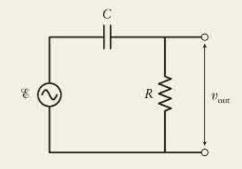Question: A circuit that allows emfs in one angular-frequency range to pass through essentially unchanged but prevents emfs in other angular-frequency ranges from passing through is
A circuit that allows emfs in one angular-frequency range to pass through essentially unchanged but prevents emfs in other angular-frequency ranges from passing through is called a filter. Such a circuit is useful in a variety of electronic devices, including audio electronics. An example of a filter, called a bigh-pass filter, is shown in Figure 32.57. Emfs that have angular frequencies above a certain angular frequency, called the cutoff angular frequency \(\omega_{c}\), pass through to the two output terminals marked \(v_{\text {out }}\), but the filter attenuates the amplitudes of emfs that have frequencies below the cutoff value.
(a) Determine an expression that gives, in terms of \(R\) and \(C\), the cutoff angular frequency \(\omega_{\mathrm{c}}\) at which \(V_{R}=V_{\mathrm{C}}\).
(b) Determine the potential difference amplitude \(v_{\text {out }}\) across the output terminals for \(\omega \gg \omega_{\mathrm{c}}\) and for \(\omega \ll \omega_{\mathrm{c}}\).
Data from Figure 32.57

C R V
Step by Step Solution
3.31 Rating (154 Votes )
There are 3 Steps involved in it
Solution a Computing the Cutoff Angular Frequency c We observe that at the cutoff frequency the magn... View full answer

Get step-by-step solutions from verified subject matter experts


